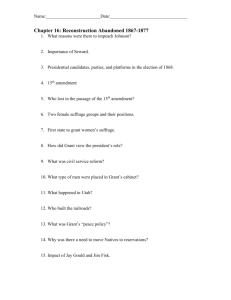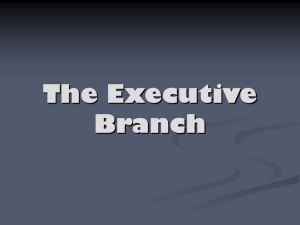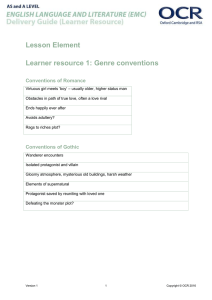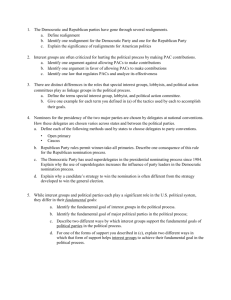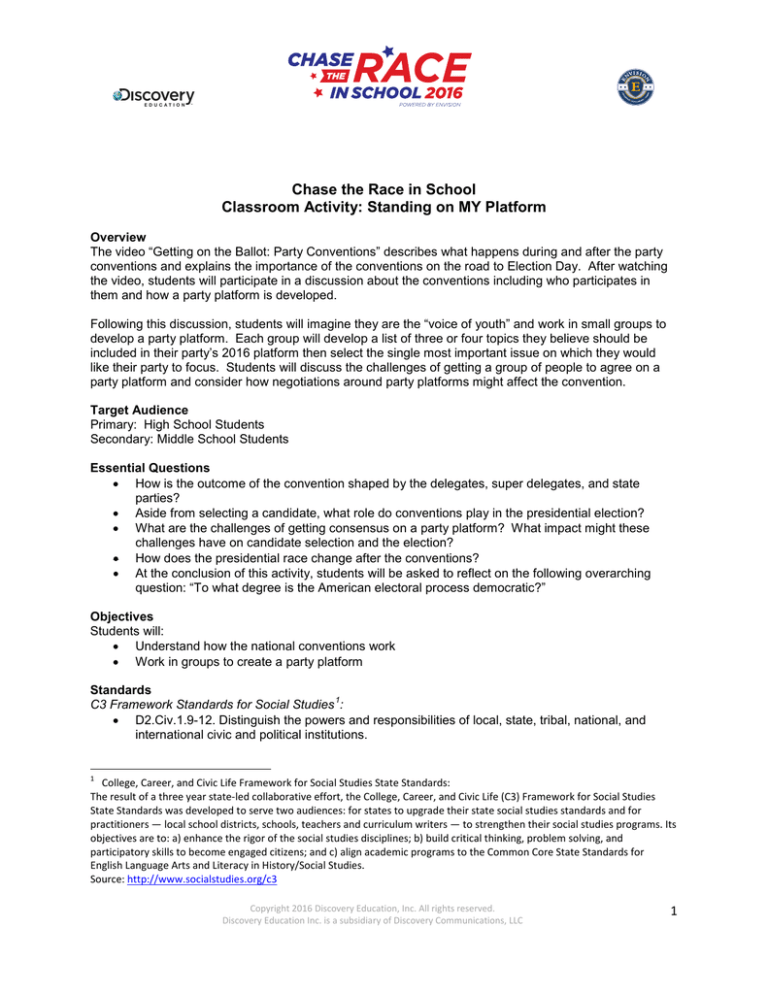
Chase the Race in School
Classroom Activity: Standing on MY Platform
Overview
The video “Getting on the Ballot: Party Conventions” describes what happens during and after the party
conventions and explains the importance of the conventions on the road to Election Day. After watching
the video, students will participate in a discussion about the conventions including who participates in
them and how a party platform is developed.
Following this discussion, students will imagine they are the “voice of youth” and work in small groups to
develop a party platform. Each group will develop a list of three or four topics they believe should be
included in their party’s 2016 platform then select the single most important issue on which they would
like their party to focus. Students will discuss the challenges of getting a group of people to agree on a
party platform and consider how negotiations around party platforms might affect the convention.
Target Audience
Primary: High School Students
Secondary: Middle School Students
Essential Questions
• How is the outcome of the convention shaped by the delegates, super delegates, and state
parties?
• Aside from selecting a candidate, what role do conventions play in the presidential election?
• What are the challenges of getting consensus on a party platform? What impact might these
challenges have on candidate selection and the election?
• How does the presidential race change after the conventions?
• At the conclusion of this activity, students will be asked to reflect on the following overarching
question: “To what degree is the American electoral process democratic?”
Objectives
Students will:
• Understand how the national conventions work
• Work in groups to create a party platform
Standards
1
C3 Framework Standards for Social Studies :
• D2.Civ.1.9-12. Distinguish the powers and responsibilities of local, state, tribal, national, and
international civic and political institutions.
1
College, Career, and Civic Life Framework for Social Studies State Standards:
The result of a three year state-led collaborative effort, the College, Career, and Civic Life (C3) Framework for Social Studies
State Standards was developed to serve two audiences: for states to upgrade their state social studies standards and for
practitioners — local school districts, schools, teachers and curriculum writers — to strengthen their social studies programs. Its
objectives are to: a) enhance the rigor of the social studies disciplines; b) build critical thinking, problem solving, and
participatory skills to become engaged citizens; and c) align academic programs to the Common Core State Standards for
English Language Arts and Literacy in History/Social Studies.
Source: http://www.socialstudies.org/c3
Copyright 2016 Discovery Education, Inc. All rights reserved.
Discovery Education Inc. is a subsidiary of Discovery Communications, LLC
1
•
•
D2.Civ.2.9-12. Analyze the role of citizens in the U.S. political system, with attention to various
theories of democracy, changes in Americans’ participation over time, and alternative models
from other countries, past and present.
D2.Civ.8.9-12. Evaluate social and political systems in different contexts, times, and places, that
promote civic virtues and enact democratic principles.
2
Common Core English Language Arts Anchor Standards :
Research to Build and Present Knowledge:
• CCSS.ELA-LITERACY.CCRA.W.7 Conduct short as well as more sustained research
projects based on focused questions, demonstrating understanding of the subject under
investigation.
Comprehension and Collaboration:
• CCSS.ELA-LITERACY.CCRA.SL.1 Prepare for and participate effectively in a range of
conversations and collaborations with diverse partners, building on others' ideas and
expressing their own clearly and persuasively.
Materials
• Computers or tablets with internet access
• Republican Party Platform
• Democratic Party Platform
Procedures
1. Have students watch the Video “Getting on the Ballot: Party Conventions.”
2. Assign or have students select groups for their work.
3. Groups will discuss the video, paying particular attention to the following questions:
• How is the outcome of the convention shaped by the delegates, super delegates, and
state parties?
• Aside from the goal of selecting a candidate, what role do conventions play in the
presidential election?
• How does the presidential race change after the conventions?
4. Ask groups to share their conclusions and provide examples from the current election to support
their answers.
5. Have students visit the Democratic and Republican Party websites in the Materials section to
browse some of the topics and information of the parties’ current platforms.
6. Working as the “voice of youth,” student groups will now develop a party platform. Each group
should create a list of three or four topics they believe are pertinent in the current election to
people their age.
7. Using negotiation, groups should select one of the topics to be the primary focus for their party.
2
The Common Core State Standards for English Language Arts & Literacy in History/Social Studies, Science, and Technical
Subjects (“the standards”) represent the next generation of K–12 standards designed to prepare all students for success in
college, career, and life by the time they graduate from high school. The standards establish guidelines for English language
arts (ELA) as well as for literacy in history/social studies, science, and technical subjects. Because students must learn to read,
write, speak, listen, and use language effectively in a variety of content areas, the standards promote the literacy skills and
concepts required for college and career readiness in multiple disciplines.
Copyright 2016 Discovery Education, Inc. All rights reserved.
Discovery Education Inc. is a subsidiary of Discovery Communications, LLC
2
8. Ask groups to share their focus topic with the class. In addition, they should explain how their
group was able to reach a consensus on the topic of choice and respond to the following
questions:
• What are the challenges of getting consensus on a party platform?
• What impact might these challenges have on candidate selection? On the election?
• How difficult might it be to reach a consensus with a much larger group, such as the
convention delegates? Would the group be more or less diverse than your group? How
do you suppose they might make their opinions known?
9. As a follow up, have students work in groups to identify ways they can make their opinions heard,
even though most cannot participate in party conventions. Encourage students to use the
internet, local and national news sources, and school organizations to learn more about how
young adults can help shape political platforms even before they can vote. There are many
organizations that welcome teens and where teens can volunteer and be a part of the political
process—even from the sidelines.
Copyright 2016 Discovery Education, Inc. All rights reserved.
Discovery Education Inc. is a subsidiary of Discovery Communications, LLC
3
Optional Extension
For a historic look at party platforms, have your student groups look at party platforms in history and try to
identify—by looking at what was going on around the world at that time—why the party chose those
topics. For example, the Democrats and Republicans included items related to the economy, trade, and
the military in their 1932 platforms, which was influenced by the Great Depression and the situation in the
world following WWI and what was happening in Europe at the time.
Resources
• This site provides links to political party platforms from 1840-2012.
o http://www.presidency.ucsb.edu/platforms.php
• An interesting look at the party platforms from the 1860 presidential election, your students may
be interested in researching these pre-Civil War documents.
o http://www.ushist.com/generalinformation/1860_national_presidential_election_platforms.shtml
• At this site, you can see a comparison of the Democratic and Republican Party platforms from
2012.
o http://compare2012.returncontrol.com/
• Here you will find the Libertarian Party platform.
o https://www.lp.org/platform
• This easy-to-use chart compares the Democratic, Republican, and Libertarian Party platforms.
o http://www.imperfectparent.com/resources/government/political-party-platforms/
• This article explains the history of the implementation of superdelegates in national conventions.
o http://www.cbsnews.com/news/whats-a-superdelegate/
• This website lists many ways youth can get involved in the political process.
o http://ysa.org/act/programs/servicevote/
Copyright 2016 Discovery Education, Inc. All rights reserved.
Discovery Education Inc. is a subsidiary of Discovery Communications, LLC
4

